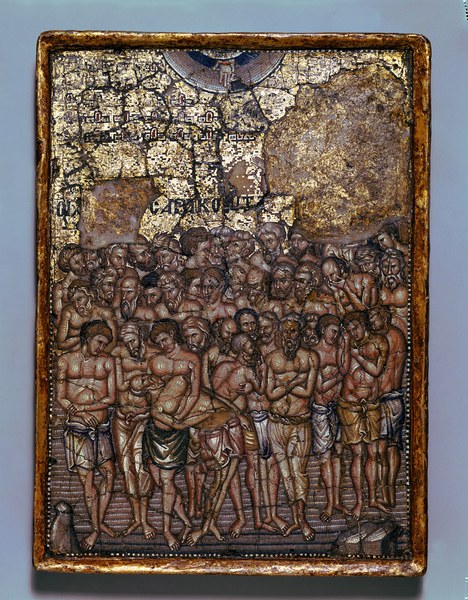On display in the Byzantine Collection at Dumbarton Oaks is an exceptional Byzantine micro-mosaic icon of the forty martyrs of Sebasteia that dates to around 1300 CE. The icon depicts forty Roman soldiers, who, having converted to Christianity, refused to worship Emperor Licinius (308–324) or any of the pagan gods. As punishment, they were placed on a frozen lake at Sebasteia in Asia Minor and given the option to face certain death or recant and have the refuge of a warm bath building, which they could see from the lake. This building may have been depicted on the mosaic, as it is in many other representations, but damage in the upper right corner makes its presence uncertain. Measuring just 22 centimeters by 16 centimeters (approximately 8½ inches by 6½ inches), this icon displays an amazing level of miniature detail work and demonstrates a remarkable skill on the part of its creator. The icon is made from literally thousands of minuscule cubes of stone and glass that have been embedded in wax to create the composition.
Perhaps just as noteworthy as this artwork’s construction is the story of how it became part of the Byzantine collection at Dumbarton Oaks. In 1931, the Blisses’ friend and adviser, Royall Tyler, wrote to Mildred Bliss about the work, noting that it was “very beautiful,” “marvelous technically,” and “infinitely varied and rich.” He reported that there were several “interested parties” looking at it, including representatives from the Louvre Museum, the Greek collector Antonis Benakis, as well as Hayford Peirce, a fellow Byzantine enthusiast and rival collector who was on friendly terms with Royall Tyler and the Blisses. Tyler noted that Peirce was willing to pay £1200 at most to secure the mosaic icon—an offer that Tyler considered unreasonably low, as he speculated the icon could be worth over £3000 ($250,000 in 2014 dollars). He wrote to Mildred Bliss on May 7, 1931:
In view of the quality of the thing, I think £2500 would not be an excessive price—though perhaps it might be got cheaper, I don’t think poor Hayford stands much of a chance of getting it for £1200 which is the most he is prepared to give. Please let me know how much you would give—if you want to try. . . .
These miniature mosaics are of exceeding rarity—much rarer than enamels, and the technique is of enormous difficulty. If you really wanted to make sure of it you’d have to be prepared to go higher than £2500—for it really seems that [the dealer] Indjoudjian got £3000 for his which was much more damaged than this one.
The Blisses hesitated, and Peirce was able to secure the icon at a substantially reduced price, as Tyler reported to Mildred Bliss in a letter of August 12, 1931: “Yes, there is news of the 40 martyrs. Hayford has it. Just before I left Paris the jobber who had it in hand betrayed anxiety to sell it at once—he was returning to Greece—and after a few days of furious comedy Hayford got it for £880. I think it’s a good buy.” £880 in 1931 was approximately the equivalent of $73,000 in 2014 dollars.
Peirce would retain ownership of the artwork for the duration of his life. In October 1947, sixteen years after the Blisses had first considered acquiring the micro-mosaic, Peirce’s widow Polly donated the mosaic to the Dumbarton Oaks Research Library and Collection in her husband’s memory.
The mosaic icon was on display in the September round of the special exhibition, 75 Years/75 Objects.
